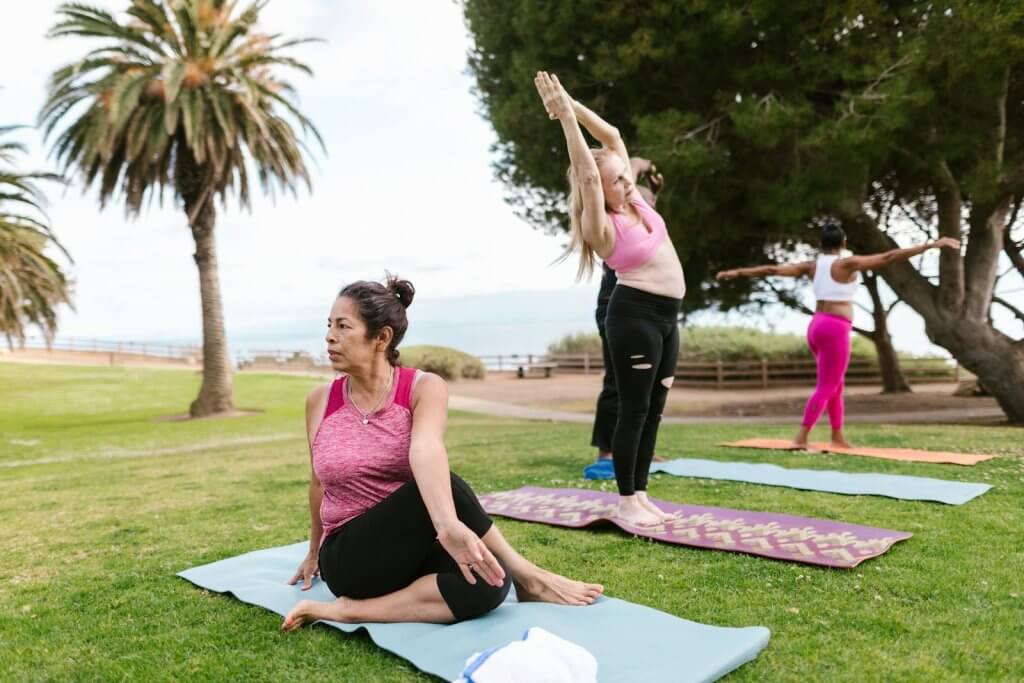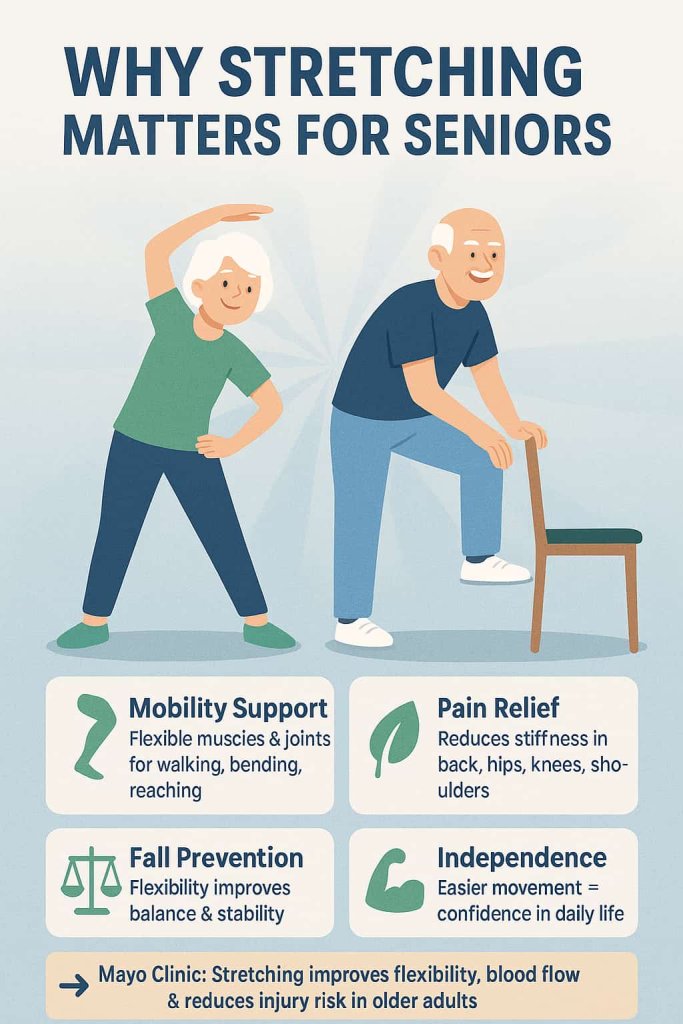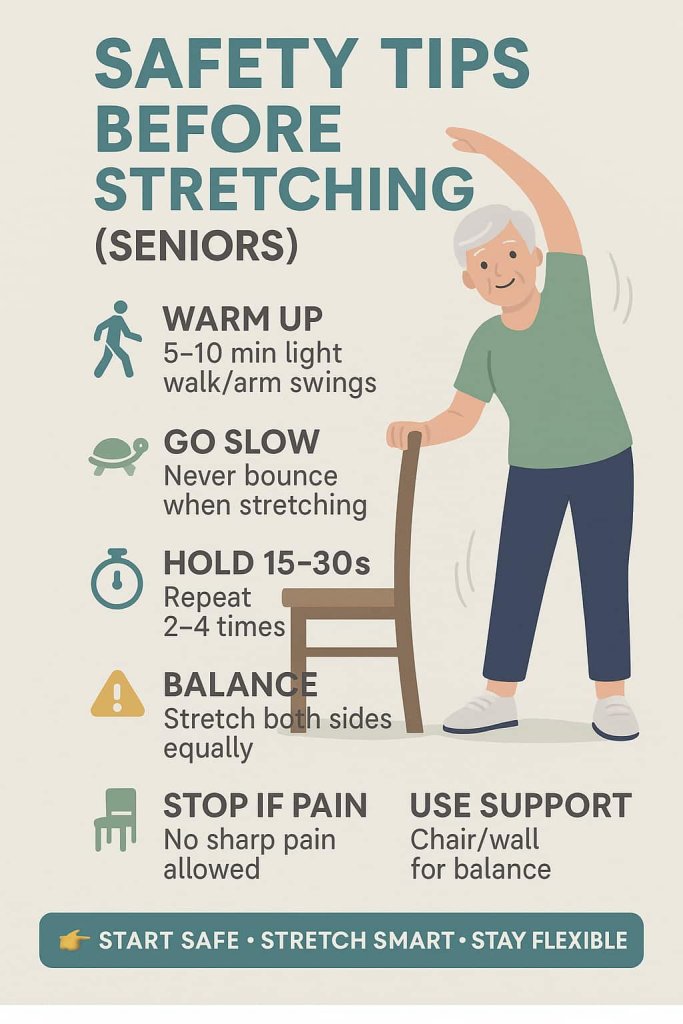Yes — seniors can greatly improve mobility and reduce pain with safe, regular stretching exercises. Even simple daily stretches increase flexibility, protect joints, and make daily movements like walking, standing, and bending much easier. For older adults, maintaining mobility is key to independence and quality of life.

This guide covers the 15 best stretching exercises for seniors with clear instructions, benefits, and safety tips. All stretches can be adapted for different ability levels and done at home with minimal equipment.
Why Stretching Matters for Seniors

- Mobility support – Stretches keep muscles and joints flexible for walking, bending, and reaching.
- Pain relief – Regular stretching reduces stiffness in the back, hips, knees, and shoulders.
- Fall prevention – Flexibility helps with balance and stability.
- Independence – Easier movement means confidence in daily tasks.
👉 According to the Mayo Clinic, stretching improves flexibility, increases blood flow, and helps reduce injury risk in older adults (Mayo Clinic).
Safety Tips Before Stretching

- Warm up with 5–10 minutes of light activity (walking, arm swings).
- Stretch slowly — never bounce.
- Hold each stretch 15–30 seconds; repeat 2–4 times.
- Stretch both sides equally.
- Stop if you feel sharp pain.
- Use a chair or wall for support if needed.
15 Best Stretching Exercises for Seniors
Staying flexible is one of the best ways for seniors to reduce stiffness, ease pain, and maintain independence. These 15 gentle senior stretching exercises target major muscle groups, improve mobility, and support balance—making daily activities like walking, climbing stairs, and reaching overhead easier and safer.
1. Neck Stretch & Shoulder Rolls
Muscles worked: Neck, upper traps, shoulders
How to do it:
- Sit or stand tall.
- Slowly tilt your head side to side (ear toward shoulder), then forward and back.
- Roll your shoulders in slow circles forward and backward.
Benefits: Relieves neck stiffness, reduces shoulder tension, and improves posture.
Trainer Tip: Keep movements slow and controlled. Avoid rolling your head in a full circle to protect your neck joints.
Duration: 15–20 seconds per stretch, repeat 2–3 times.
2. Chest Opener (Doorway Stretch)
Muscles worked: Chest, shoulders
How to do it:
- Stand in a doorway.
- Place forearms or hands against the frame at shoulder height.
- Step forward gently until you feel a stretch in the chest.
Benefits: Opens the chest, counteracts hunching, and supports deeper breathing.
Trainer Tip: Keep your shoulders down and relaxed—don’t shrug.
Duration: Hold for 20–30 seconds. Repeat 2 times.
3. Overhead Triceps Stretch (Towel Stretch)
Muscles worked: Triceps, shoulders
How to do it:
- Hold a towel overhead with one hand.
- Drop the towel behind your back.
- Reach up with the opposite hand and gently pull downward.
Benefits: Improves shoulder mobility, relieves stiffness, and enhances overhead reach.
Trainer Tip: Keep elbows close to your head, not flaring out.
Duration: 15–20 seconds per side, repeat 2 times.
4. Seated Hamstring Stretch
Muscles worked: Hamstrings, lower back
How to do it:
- Sit tall on a sturdy chair.
- Extend one leg straight out with heel on the floor.
- Lean forward slightly with a straight back until you feel a stretch.
Benefits: Reduces hamstring tightness, relieves lower back pain, and improves walking mobility.
Trainer Tip: Keep your back flat, avoid rounding forward.
Duration: Hold 20–30 seconds per leg.
5. Quadriceps Stretch
Muscles worked: Front thighs
How to do it:
- Stand holding a chair for balance.
- Bend one knee, bringing heel toward buttocks.
- Hold ankle gently and keep knees close together.
Benefits: Relieves knee stress, improves stair climbing and walking ease.
Trainer Tip: Keep hips tucked slightly to avoid arching your back.
Duration: 20 seconds per leg, repeat 2 times.
6. Wall Calf Stretch
Muscles worked: Calves, Achilles tendon
How to do it:
- Stand facing a wall.
- Step one foot back, pressing heel into the floor.
- Lean forward toward the wall until calf stretches.
Benefits: Reduces calf cramps, improves ankle flexibility, and supports balance.
Trainer Tip: Keep toes pointing forward and back leg straight.
Duration: Hold 20–30 seconds per leg.
7. Hip Flexor Stretch
Muscles worked: Hip flexors, lower back
How to do it:
- Step one foot forward into a gentle lunge.
- Kneel on the back leg if comfortable, or keep it straight.
- Push hips forward until stretch is felt in front of hip.
Benefits: Relieves lower back tension, improves posture, and eases sitting stiffness.
Trainer Tip: Keep chest upright—avoid leaning forward.
Duration: 20 seconds per side.
8. Seated Figure-Four Stretch
Muscles worked: Hips, glutes
How to do it:
- Sit on a chair with feet flat.
- Cross one ankle over the opposite thigh.
- Lean forward gently until you feel a stretch in the hip and glute.
Benefits: Relieves hip tightness, eases sitting discomfort, supports mobility.
Trainer Tip: Keep back straight, avoid hunching forward.
Duration: Hold 20 seconds per side.
9. Seated Spinal Twist
Muscles worked: Spine, obliques
How to do it:
- Sit tall with feet flat.
- Cross one leg over the other if comfortable.
- Place opposite hand on knee and twist torso gently.
Benefits: Improves spinal mobility, reduces stiffness, aids digestion.
Trainer Tip: Keep shoulders relaxed and twist only to a comfortable range.
Duration: 15–20 seconds per side.
10. Knee-to-Chest Stretch
Muscles worked: Lower back, hips
How to do it:
- Lie on your back with knees bent.
- Pull one knee toward chest, keeping the other foot flat.
- Switch sides.
Benefits: Relieves lumbar tension and eases lower back pain.
Trainer Tip: Use both hands under the thigh if pulling from shin feels uncomfortable.
Duration: Hold 20 seconds per leg.
11. Side Bend Stretch
Muscles worked: Side body, obliques, spine
How to do it:
- Sit or stand tall.
- Raise one arm overhead.
- Lean gently to the opposite side.
Benefits: Increases lateral flexibility, improves reach and spinal health.
Trainer Tip: Avoid leaning forward or backward—keep chest lifted.
Duration: 15–20 seconds per side.
12. Ankle Circles & Toe Flexes
Muscles worked: Ankles, calves
How to do it:
- Sit or lie down.
- Lift one foot off floor.
- Rotate ankle in slow circles both directions.
- Flex toes toward shin and then point forward.
Benefits: Improves ankle mobility, balance, and circulation—key for fall prevention.
Trainer Tip: Perform slowly to engage stabilizing muscles.
Duration: 8–10 circles each way, 8–10 flexes.
13. Cat-Cow Stretch
Muscles worked: Spine, core
How to do it:
- On hands and knees (or seated with hands on knees).
- Inhale, arch back (cow).
- Exhale, round spine (cat).
Benefits: Promotes spinal flexibility, eases stiffness, improves core awareness.
Trainer Tip: Move gently with your breath—avoid forcing range of motion.
Duration: 6–8 slow repetitions.
14. Hamstring Wall Stretch
Muscles worked: Hamstrings, hips
How to do it:
- Lie on your back near a wall.
- Extend one leg up against the wall, other leg flat.
- Relax into the stretch.
Benefits: Relieves hamstring tightness, supports hip mobility, eases back stress.
Trainer Tip: Keep lower back relaxed—don’t force leg straight.
Duration: Hold 20–30 seconds per side.
15. Seated March / Hip Flex Stretch
Muscles worked: Hips, glutes, thighs
How to do it:
- Sit tall in a chair with feet flat.
- Lift one knee toward chest like marching.
- Alternate legs slowly.
Benefits: Strengthens hips, improves circulation, supports walking endurance.
Trainer Tip: Use armrests for balance if needed.
Reps: 8–10 marches per leg, repeat 2 sets.
How Often Should Seniors Stretch?
Experts recommend doing senior stretching exercises at least 2–3 times per week, but daily stretching is ideal. Even 10–15 minutes a day can significantly improve flexibility, reduce stiffness, and support long-term mobility.
Who Should Avoid Certain Stretches?
- Seniors with severe osteoporosis should avoid deep spinal twists or forward bends.
- Those with balance issues should use a chair or wall support.
- Always consult a doctor before starting if you have arthritis, chronic pain, or heart conditions.
FAQs About Stretching Exercises for Seniors
1. Is stretching safe for seniors with arthritis?
Yes, gentle stretching helps reduce stiffness. Avoid forcing painful joints.
2. What time of day is best to stretch?
Morning stretches relieve stiffness, while evening stretches relax muscles before bed.
3. How long should seniors hold a stretch?
15–30 seconds per stretch is ideal. Repeat 2–4 times per muscle group.
4. Can stretching alone improve balance?
Stretching helps, but combine with strength and balance training for best results.
5. Do seniors need equipment for stretching?
No. A chair, towel, or wall is enough for most stretches.
6. Can stretching reduce back pain?
Yes, stretches like hamstring, knee-to-chest, and cat-cow relieve lower back stiffness.
7. Should seniors stretch every day?
Yes, daily stretching is safe and highly beneficial if done gently.
Conclusion
Stretching is one of the simplest and most effective ways for seniors to stay mobile, reduce pain, and remain independent. The 15 exercises above target all major muscle groups and can be adapted for any fitness level.
👉 Start with a few stretches today and gradually build a daily routine. Your body will thank you with less stiffness, more energy, and better mobility.
